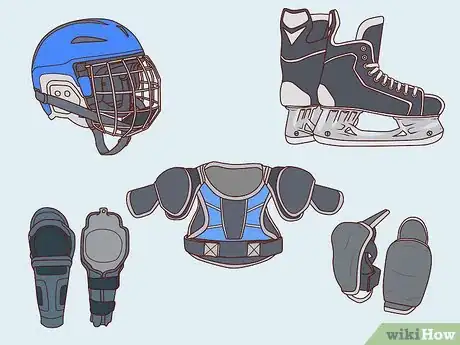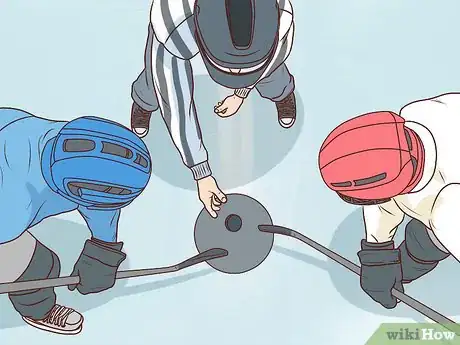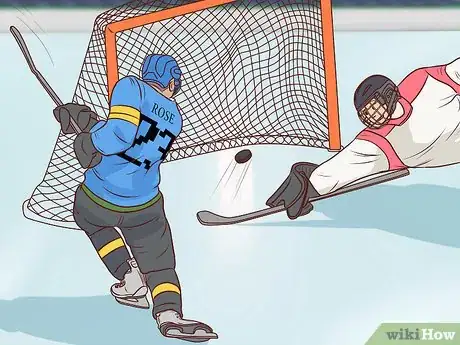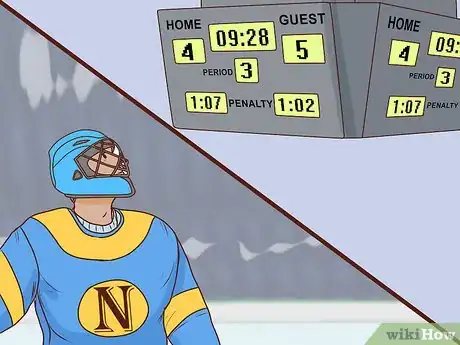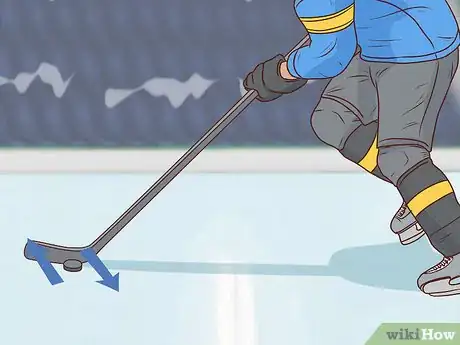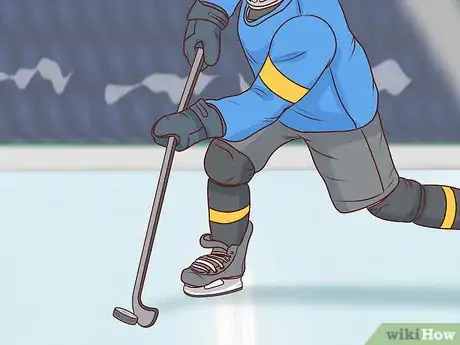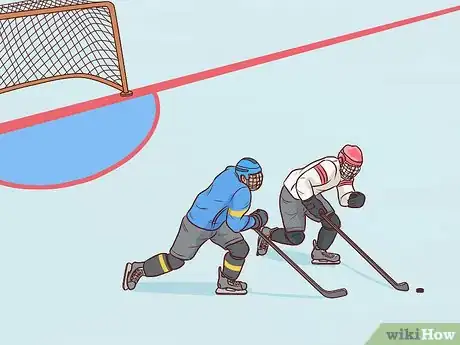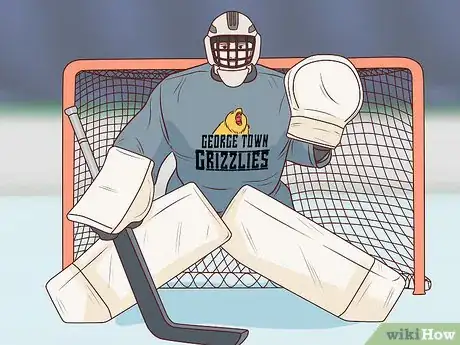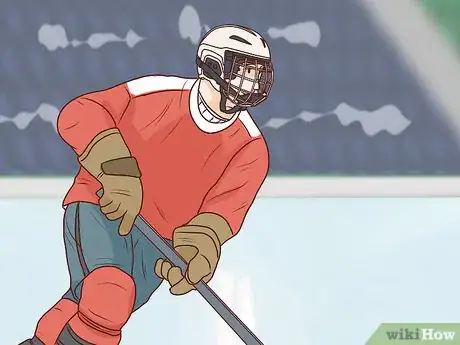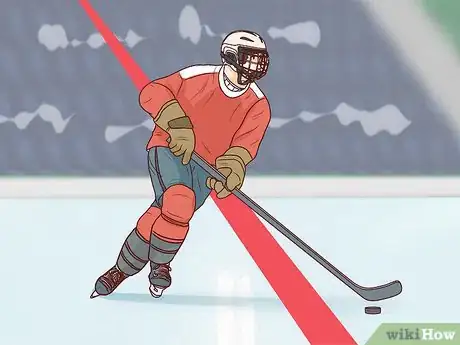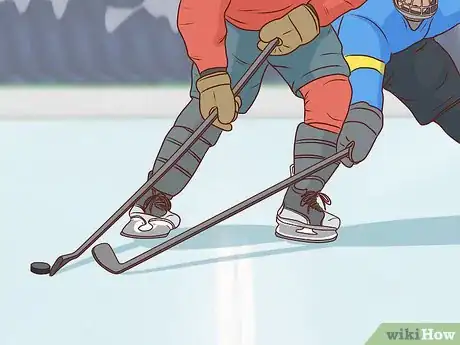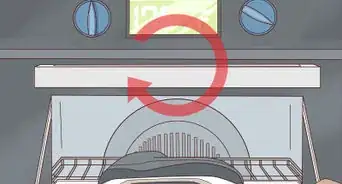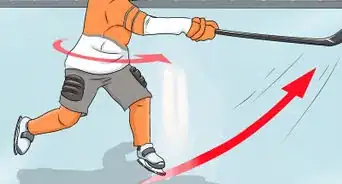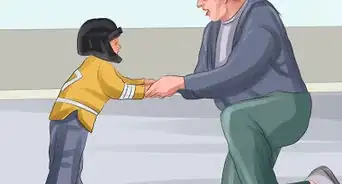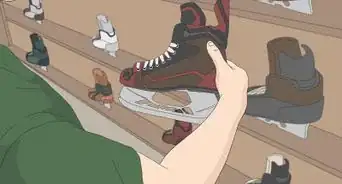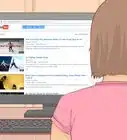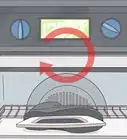This article was co-authored by wikiHow staff writer, Hunter Rising. Hunter Rising is a wikiHow Staff Writer based in Los Angeles. He has more than three years of experience writing for and working with wikiHow. Hunter holds a BFA in Entertainment Design from the University of Wisconsin - Stout and a Minor in English Writing.
There are 11 references cited in this article, which can be found at the bottom of the page.
This article has been viewed 214,486 times.
Learn more...
Hockey is a full-contact sport played on an ice rink between 2 teams made up of 6 players each. You score goals by shooting the puck into your opponent's goal, and the team that has the most goals at the end of 3 periods wins. If you want to play hockey, you will need to get comfortable with the gear and practicing skating quickly and efficiently. With a lot of practice and hard work, you will be able to try all the positions in a hockey game.
Steps
Learning the Basic Rules
-
1Wear a helmet, pads, and hockey skates. Since hockey is a full contact sport, you will need to wear protective padding and helmets so you will not get injured if you fall on the ice. Make sure you get pads and helmets that fit your body type and secure them tightly. You will also need a good pair of hockey skates that offer ankle support and mobility.[1]
- Never play ice hockey without any protective gear.
- Do not use regular ice skates since they limit your mobility and will not be as effective as skates designed for hockey.
-
2Learn the layout of the rink. The hockey rink is divided into 3 sections marked by the blue lines on the ice. The center section with the thick red line is the neutral zone and the zones with the goals are that respective team’s zones. A thin red lines on the ends of the rink are the goal lines where the goals are located.
- The semicircle on each goal line represents the crease, or the area where the goalie plays.
- There are multiple circles on the rink that represent areas where you may have a face-off. The face-off circles are usually used after a penalty.
Advertisement -
3Start the game with a face-off in the center of the rink. The dot in the center of the rink is the starting position where you’ll have a face-off at the start of the game. When the referee drops the puck, use your hockey stick to fight for control of the puck. Once the puck is down, the game clock will start running.[2]
- You will also have face-offs at the start of each game period and after each point.
- You may have face-offs after certain penalties as well.
-
4Score goals by hitting the puck into the opponent’s goal. The main goal of the game is to get the puck into your opponent’s goal on their side of the rink. Use your stick to shoot the puck into the goal to score 1 point for your team. If you are playing goalie, try to defend your goal from the puck so the other team cannot score.[3]
- There are no limits to how many points you can score during a game.
- After each goal, have a face-off on the center line.
-
5Avoid getting any penalties. Hockey has minor and major penalties that could cause you to get taken out of the game for 2 or 5 minutes. When the referee blows the whistle, stop playing the game and watch the hand signals they give to determine what the penalty was and who it was called on. Common penalties include:
- Dangerous use of the stick, including slashing or high-sticking
- Obstruction penalties, including hooking or tripping.
- Interfering with or checking a player not in control of the puck
- Checking from behind or by targeting the head
Tip: During the penalty, the team that is down a player cannot substitute them with a different player.
-
6Play through 3 periods to complete the game. A period consists anywhere from 12-20 minutes depending on the league you are playing with. When a period is over, take a short break off the ice and talk with your team. During the next period, switch the side of the rink you are playing on and continue the game. After the third period, the team with the most points wins![4]
- If the game is tied after the third period, play another overtime period.
Practicing Fundamental Skills
-
1Practice skating forward and backward. Keep your knees bent while you are skating to get the most range and power. Push off of 1 leg and lift the opposite leg to practice gliding on the ice and maintaining your balance. When you want to skate backward, glide your feet back in a C-shape.[5]
- Skate before you start playing hockey so you feel confident on the ice.
- Practice braking and coming to a stop by turning your feet sideways and pushing down into the ice.
Tip: Try gripping the ice with your skates and taking side-steps to improve your game. These are known as crossovers and can help you change directions quickly while you are skating.
-
2Move and control the puck with your hockey stick. In your non-dominant hand, hold the ball at the end of the stick handle, centering the stick with your body. Place your dominant hand 2 glove-lengths down from the top. Shuffle the puck back and forth to dribble it so you have the most control. Practice dribbling it while you are standing still before you starting to skate with it.
- Make sure you are using a stick curved in the opposite direction as your dominant hand. For example, if you are right-handed, use a stick where the blade curves to the left.
- Try to keep your eyes up and forward rather than looking down at the puck.
-
3Pass the puck between players to move it quickly. Use a quick sweeping motion to push the puck to another player. Try to keep the puck as low to the ground as you can so it will not lose control. Follow through with the sweeping motion completely to get the speed and angle correct. When you are catching a pass, angle the blade on your stick down so the puck does not jump off the ice.[6]
- Do not slap the puck when passing since it will be hard for your teammate to catch it.
-
4Flick your wrist forward to make quick, accurate shots. Shift your weight onto your back leg and keep the puck as close to the middle of the blade as possible. Sweep the puck forward and flick your wrists at the last minute to give the puck momentum and thrust. When your shot is finished, make sure the end of the hockey stick's blade points in the direction you want to shoot. This will help guide the puck during your follow through.[7]
Choosing a Position
-
1Drive the puck to the opponent's side of the rink if you are a forward. The 3 forward positions include the center, the right winger, and the left winger. Stay near the center of the rink and on your opponent's side while you have the puck. Pass the puck between the other forwards for the best opportunity to score. Play a forward position if you want to score goals and be offensive during the game.[8]
- The center also participates in face-offs after a point is scored or at the start of a new period.
- When you are playing as a winger, do your best to stay on the side of the rink you are assigned to.
Warning: Be sure not to cross the blue line closest to your opponent's zone before the puck does or else you will get an off-sides penalty.
-
2Keep the puck away from your goal if you are playing defense. Each hockey team has 2 defensemen that stay mostly on their goal's side of the rink. When you are playing defense, cover the members of your opponent's team so it is more difficult for them to score. Chase after the player with the puck to try and steal it from them and make it harder for them to score. When you get the puck, pass it to one of the wingers or the center so they can take it to the other side of the rink.[9]
- Always keep an eye on the players on the other team. Be sure to cover anyone near your goal so they do not get the puck.
- Try setting up a zone defense where each defensive player protects a certain part of the rink.
-
3Protect the goal if you are the goalie. The goalie is the last line of defense against your opponent and they can stop the puck from going into the goal. Always pay attention to where the puck is and move to the side of the goal closest to it. When you see a player lining up a shot, watch where the puck is going and try to stop it with your glove, sticks, or pads.[10]
- Goalies can hold onto the puck if they catch it and force another face-off to happen on one of the circles on the rink.
- Pucks can move extremely fast toward you. Make sure you always stay alert of where the puck is coming from.
Playing the Game Well
-
1Keep your head up rather than looking at your feet. Instead of looking down at your feet or the puck while you have it, stay alert and look forward to see where other players are. Keep an eye on your opponents as well as your other teammates so you can set up passes and shots.[11]
- Practice dribbling the puck on your own and looking away from it to help develop better handling skills.
-
2Spread your team out so you can pass between one another. Do not all gather around or chase after the puck. Work together as a team and spread out across the rink so you always have an opportunity to pass. Never stand still in one place or your opponents can easily defend against you. Keep moving and finding new gaps between players where you can pass and shoot the puck.[12]
- Communicate with your teammates and always watch where they’re moving so you have more opportunities.
- Don’t try to handle the puck and score by yourself since you can easily get caught up by another player.
-
3Guide the puck toward the middle lane of the rink. The easiest way to score is going down the middle of the rink toward the goal. Always try to center the puck so you have an easy way to shoot and score against the other team. Start from the outside near the boards and work toward the goal as a team.[13]
-
4Protect the puck from other players while you are handling it. If another player is trying to take the puck from you, angle your hockey stick down to cover the puck. If you cannot cover the puck, try to hold them away from your stick with your dominant hand while you guide the puck with your non-dominant hand. Keeping the puck away from the other player will help you develop better control.[14]
- If you cannot get away from another player and they are about to steal the puck, find an open player on your team to pass it to.
Community Q&A
-
QuestionIs there an offsides rule?
 Community AnswerYes; you cannot cross the opposing team's blue line before the puck does.
Community AnswerYes; you cannot cross the opposing team's blue line before the puck does. -
QuestionHow can you get into a team?
 Community AnswerIf you're a kid, joining a local league team is an easy and fun first step. If you're in college and want to join the NHL, wait for a scout to come by and try to impress him with your hockey skills.
Community AnswerIf you're a kid, joining a local league team is an easy and fun first step. If you're in college and want to join the NHL, wait for a scout to come by and try to impress him with your hockey skills. -
QuestionWhat if you are a kid and you want to join a hockey team?
 Community AnswerThere are many local teams that you can join. if you are interested in hockey lookup youth teams in your area. Let you parents know and maybe they can help you find a local team.
Community AnswerThere are many local teams that you can join. if you are interested in hockey lookup youth teams in your area. Let you parents know and maybe they can help you find a local team.
Warnings
- Never play hockey without pads or helmets since you could easily get injured.⧼thumbs_response⧽
- Do not check anyone from behind or target their head since you could hurt the other player.⧼thumbs_response⧽
Things You Will Need
- Hockey skates
- Pads
- Hockey helmet
- Mouth guard
- Hockey stick
- Puck
References
- ↑ https://youtu.be/i6hivb5xOUU?t=38
- ↑ http://www.rulesofsport.com/sports/ice-hockey.html
- ↑ http://www.rulesofsport.com/sports/ice-hockey.html
- ↑ http://www.rulesofsport.com/sports/ice-hockey.html
- ↑ https://youtu.be/JGV76vd_Cks?t=136
- ↑ https://youtu.be/zrhRv-OEhI0?t=39
- ↑ https://youtu.be/D5u5qGQ2JwI?t=10
- ↑ https://www.evelethyouthhockey.com/page/show/52857-golden-rules-for-forwards
- ↑ https://youtu.be/sJrdxXGR-BY?t=15
About This Article
To play ice hockey, first you'll need two teams. The goal of the game is to score more points than the other team by hitting the puck into your opponent's goal. In the official rules, each team has six players and the game consists of three 20-minute periods. When you're ready to play, assign forwards, defenders, and 1 goalie on each team. Forwards try to drive the puck into the opponent's goal, while defenders work on keeping the puck away from your team's goal. The goalie's job is to block any pucks being shot directly into the goal. Once you've assigned positions, start the game by having 2 players face off for control of the puck in the center of the rink. After a team scores, or if there's a penalty called, a new face off is triggered. Since hockey is a contact sport, make sure to always wear the correct protective gear like a helmet, mouthguard, pads, and gloves. Read on for tips on learning the fundamentals and playing different positions!
